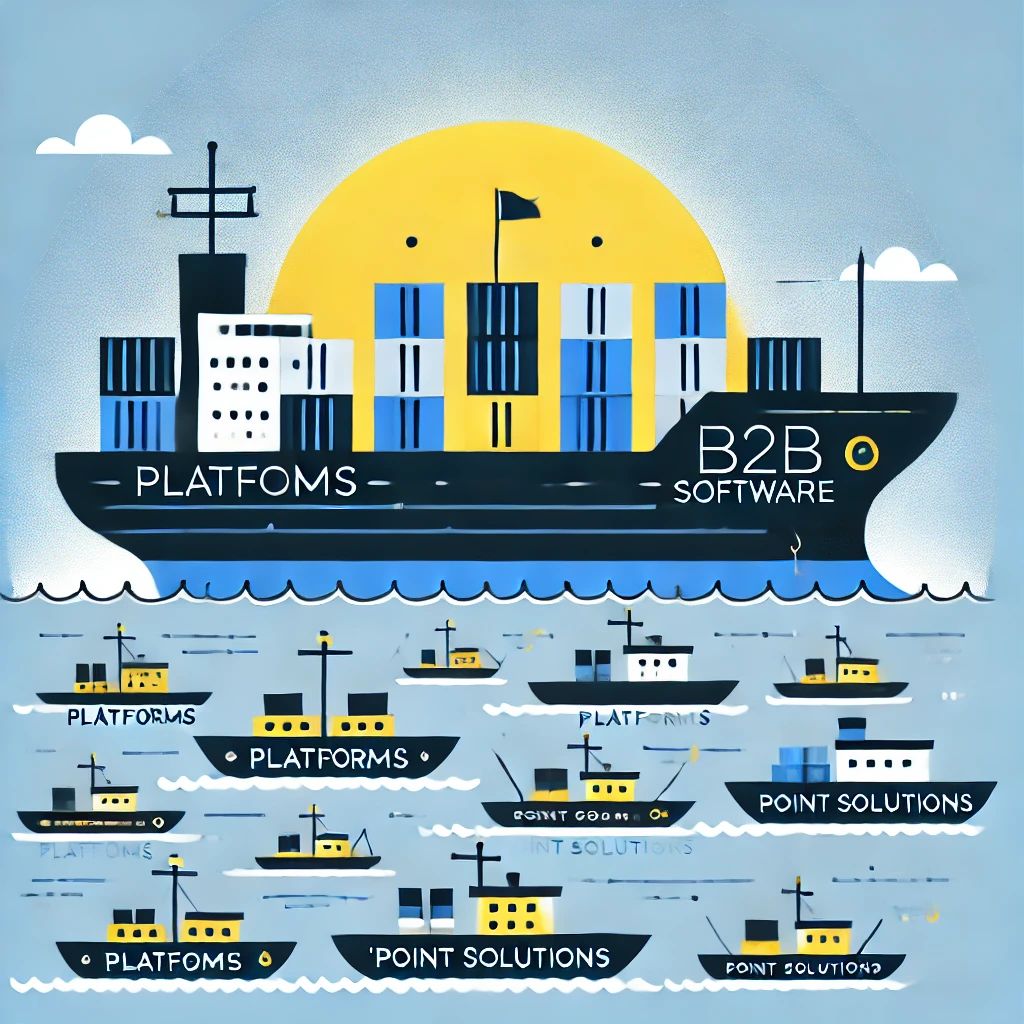B2B Platforms are crushing it
20.Jan.2025 — Evale
Data shows: B2B platforms are crushing point solutions. Here’s why: 📊💪
Jamin Ball recently highlighted in his newsletter: “It’s never been harder for point solutions to find incremental customers.”
The numbers back this up convincingly (source in comments):
1️⃣ Platforms command 2.3x higher revenue multiples than point solutions (8.2x vs 3.5x)
2️⃣ Platforms are growing faster (18% vs 11% YoY)
3️⃣ Platforms have better net expansion rates (113% vs 101%)
These stark differences in performance metrics point to a seismic shift in B2B software. But what’s driving this platform dominance?
🔗 Integration advantages: Platforms offer seamless workflows across functions
🏢 Rise of vertical software platforms: Industry-specific solutions gaining traction
💰Budget consolidation: Companies prefer fewer, more comprehensive solutions
🤖 AI advancements: Platforms leverage data across modules for smarter insights
🤝 Vendor management: Fewer suppliers means less complexity
However, it’s not all doom and gloom for point solutions. Survival strategies include:
Enhance integration: Develop robust APIs and out-of-the-box integrations for seamless connections with platforms and other solutions
Expand functionality: Broaden the solution’s capabilities to address adjacent problems within the same workflow or business process
Build comprehensive ecosystems: Cultivate sales partnerships, engage developers, and foster relationships with complementary tools
Leverage agility: Innovate rapidly to address emerging market needs
But here’s the twist: I analyzed G2 rankings and scores of 79 public SaaS companies. Here’s what the data reveals:
Platforms: 5,672 avg. reviews, 4.40 avg. score
Point Solutions: 3,274 avg. reviews, 4.41 avg. score
Surprising, right? Despite market dominance, platforms aren’t winning the satisfaction game. Reasons might be:
𝗙𝗲𝗮𝘁𝘂𝗿𝗲 𝗕𝗹𝗼𝗮𝘁: Platforms often suffer from the “kitchen sink” syndrome, cramming in every conceivable feature. This can lead to cluttered interfaces and overwhelming complexity.
𝗝𝗮𝗰𝗸 𝗼𝗳 𝗔𝗹𝗹 𝗧𝗿𝗮𝗱𝗲𝘀, 𝗠𝗮𝘀𝘁𝗲𝗿 𝗼𝗳 𝗡𝗼𝗻𝗲: Platforms may offer adequate solutions across multiple functions, but rarely excel in any single area. Point solutions can focus all their resources on perfecting a specific functionality.
𝗦𝗹𝗼𝘄𝗲𝗿 𝗜𝗻𝗻𝗼𝘃𝗮𝘁𝗶𝗼𝗻 𝗖𝘆𝗰𝗹𝗲𝘀: Large platform providers typically have more complex organizational structures, slowing down the implementation of user feedback and new features.
𝗜𝗻𝘁𝗲𝗴𝗿𝗮𝘁𝗶𝗼𝗻 𝗖𝗵𝗮𝗹𝗹𝗲𝗻𝗴𝗲𝘀: Users frequently encounter unexpected compatibility issues or clunky workflows when moving between different parts of the platform.
𝗖𝘂𝘀𝘁𝗼𝗺𝗶𝘇𝗮𝘁𝗶𝗼𝗻 𝗟𝗶𝗺𝗶𝘁𝗮𝘁𝗶𝗼𝗻𝘀: Platforms often provide a one-size-fits-all solution that may not align perfectly with specific business needs.
🤔 Given the surprising satisfaction parity between platforms and point solutions, how can buyers navigate this complex landscape?
𝗟𝗼𝗼𝗸 𝗕𝗲𝘆𝗼𝗻𝗱 𝗠𝗮𝗿𝗸𝗲𝘁 𝗦𝗵𝗮𝗿𝗲: Our data shows that popular platforms don’t necessarily deliver higher satisfaction. Consider both established platforms and innovative point solutions.
𝗔𝘀𝘀𝗲𝘀𝘀 𝗬𝗼𝘂𝗿 𝗦𝗽𝗲𝗰𝗶𝗳𝗶𝗰 𝗡𝗲𝗲𝗱s: Evaluate which functionalities are essential. A platform might seem attractive, but a point solution could better serve your core requirements.
𝗣𝗿𝗶𝗼𝗿𝗶𝘁𝗶𝘇𝗲 𝗜𝗻𝘁𝗲𝗴𝗿𝗮𝘁𝗶𝗼𝗻 𝗖𝗮𝗽𝗮𝗯𝗶𝗹𝗶𝘁𝗶𝗲s: For platforms, ensure seamless integration between modules. For point solutions, verify their ability to integrate with your existing tech stack.
𝗖𝗼𝗻𝘀𝗶𝗱𝗲𝗿 𝗧𝗼𝘁𝗮𝗹 𝗖𝗼𝘀𝘁 𝗼𝗳 𝗢𝘄𝗻𝗲𝗿𝘀𝗵𝗶𝗽: Look beyond the sticker price. Platforms may offer bundled savings, but point solutions might provide better value for your specific needs.
𝗔𝗻𝘁𝗶𝗰𝗶𝗽𝗮𝘁𝗲 𝗙𝘂𝘁𝘂𝗿𝗲 𝗡𝗲𝗲𝗱𝘀: Consider your company’s growth trajectory. Will a platform’s scalability be crucial, or can point solutions adapt to your evolving requirements?